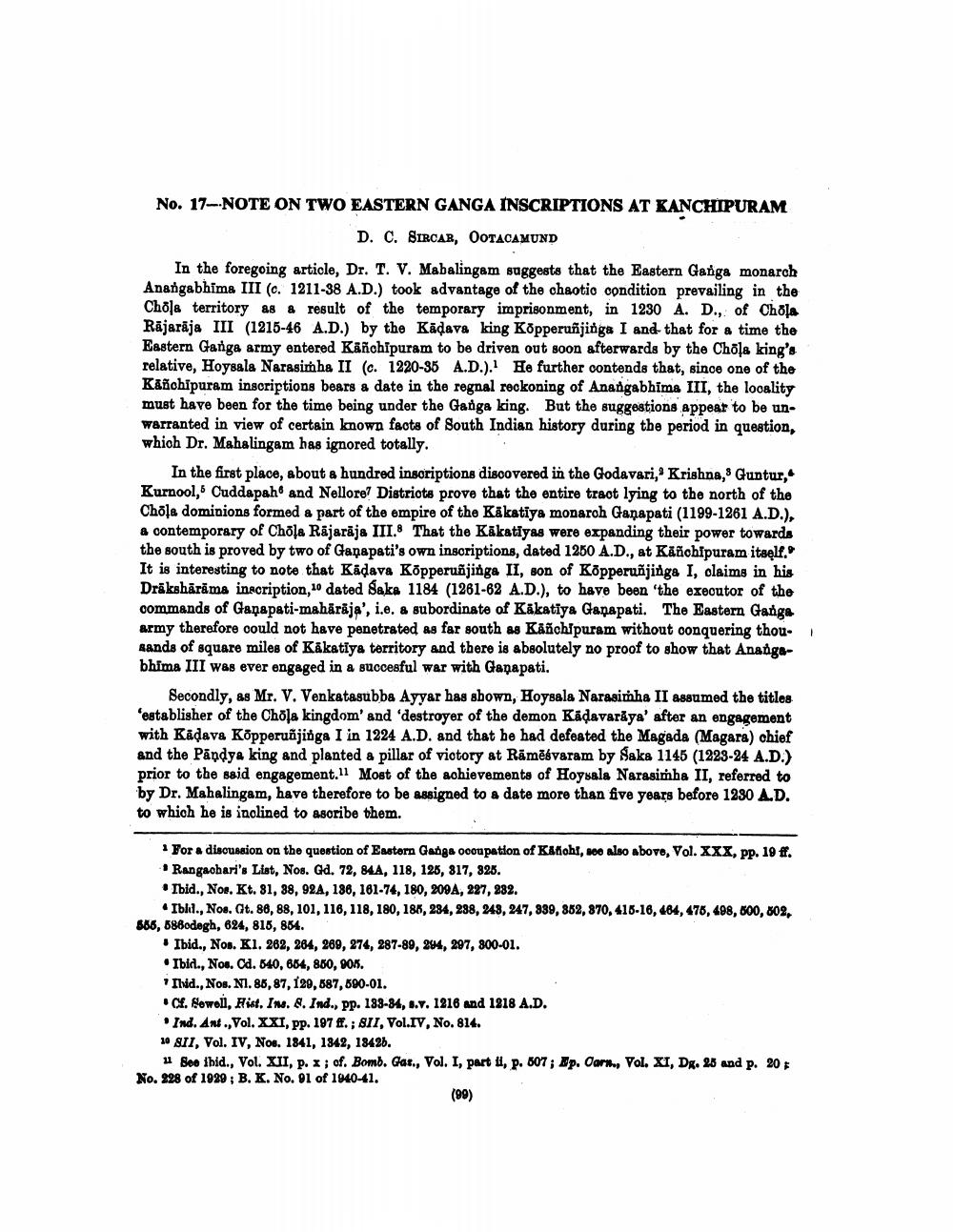________________
No. 17-NOTE ON TWO EASTERN GANGA INSCRIPTIONS AT KANCHIPURAM
D. C. SIRCAR, OOTACAMUND In the foregoing article, Dr. T. V. Mabalingam suggests that the Eastern Ganga monarch Anangabhima III (c. 1211-38 A.D.) took advantage of the chaotic condition prevailing in the Chola territory 48 & result of the temporary imprisonment, in 1230 A. D., of Chola Rājarāja III (1215-46 A.D.) by the Kādava king Köpperuñjinga I and that for a time the Eastern Ganga army entered Kanchipuram to be driven out soon afterwards by the Chola king's relative, Hoysala Narasimha II (c. 1220-35 A.D.). He further contends that, since one of the Kanohipuram inscriptions bears a date in the regnal reckoning of Anangabhima III, the locality must have been for the time being under the Ganga king. But the suggestions appear to be unwarranted in view of certain known facts of South Indian history during the period in question, which Dr. Mahalingam has ignored totally.
In the first place, about a hundred inscriptions discovered in the Godavari, Krishna, Guntur, Kurnool, Cuddapah and Nellore Districts prove that the entire traot lying to the north of the Chola dominions formed a part of the empire of the Kakatiya monarch Ganapati (1199-1261 A.D.), & contemporary of Chola Rājarāja III. That the Kākatiyas were expanding their power towards the south is proved by two of Ganapati's own inscriptions, dated 1250 A.D., at Käñchipuram itaelf." It is interesting to note that Kādava KÕpperuñjinga II, son of Kopperuñjinga I, claims in his Dräkshārāma inscription, 10 dated Saka 1184 (1261-62 A.D.), to have been the executor of the commands of Ganapati-mahārāja', i.e. a subordinate of Kakatiya Ganapati. The Eastern Ganga army therefore could not have penetrated as far south as Kanchipuram without conquering thousands of square miles of Kakatiya territory and there is absolutely no proof to show that Anadgabhima III was ever engaged in a succesful war with Ganapati.
Secondly, as Mr. V. Venkatasubba Ayyar has shown, Hoysala Narasimha II assumed the titles 'establisher of the Chola kingdom' and 'destroyer of the demon Kädavariya' after an engagement with Kadava Kopperuõjinga I in 1224 A.D. and that he had defeated the Magada (Magara) chief and the Pandya king and planted a pillar of victory at Rämēbvaram by Saks 1145 (1229-24 A.D.) prior to the said engagement.11 Most of the achievements of Hoysala Narasimha II, referred to by Dr. Mahalingam, have therefore to be assigned to a date more than five years before 1230 A.D. to which he is inclined to ascribe them.
For a discussion on the question of Eastern Ganga oooupation of Kanoht, so also above, Vol. XXX, pp. 19 ff. • Rangaohari's List, Nos. Gd. 72, 84A, 118, 126, 817, 825. • Ibid., Nos. Kt. 81, 88, 92A, 186, 181-74, 180, 200A, 227, 282.
Iblil., Nos, Gt. 88, 88, 101, 116, 118, 180, 186, 284, 288, 248, 247, 239, 882, 870, 416-16, 484,476, 488, 600, 802, 556, B8Bodegh, 624, 815, 854.
Ibid., Nos. Kl. 262, 264, 269, 274, 287-89, 294, 297, 800-01. • Ibid., Nos. Cd. 640, 654, 850, 90%. Ihid., Nos. N1. 86, 87, 129,587,590-01. C. Bowell, Hist. Ins. &. Ind., pp. 198-84, s.v. 1216 and 1218 A.D.
Ind. Ant., Vol. XXI, pp. 197 f. ; 811, Vol.IV, No. 814. 10 SIT, Vol. IV, Nos. 1841, 1842, 18425.
u Soo Ibid., Vol. XII, p. x; of. Bomb. Gar., Vol. I, part ii, p. 607; Ep. Corn., Vol. XI, Dk. 25 and p. 20 No. 928 of 1929; B. K. No. 01 of 1940-41.
(99)




